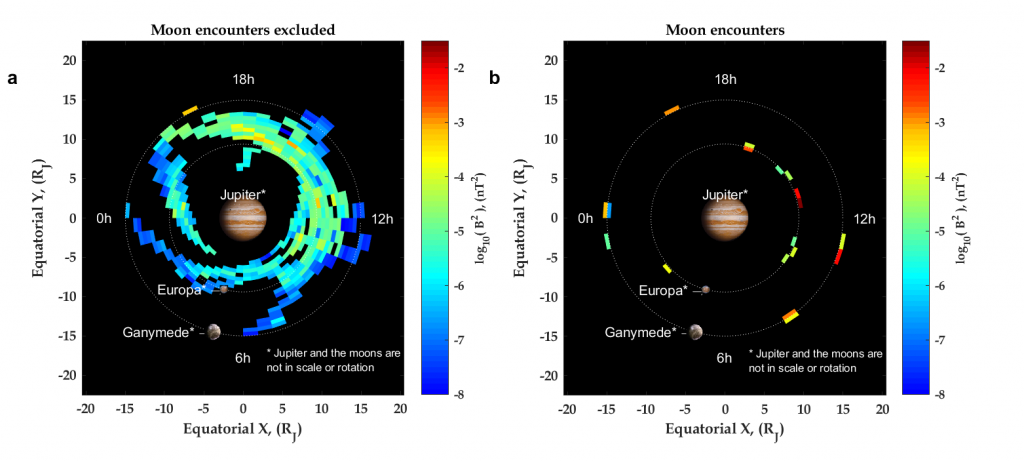In the vicinity of Europa and Ganymede, that respectively have induced and internal magnetic fields, chorus wave power is significantly increased. The observed enhancements are persistent and exceed median values of wave activity by up to 6 orders of magnitude for Ganymede. Produced waves may have a pronounced effect on the acceleration and loss of particles in the Jovian magnetosphere and other astrophysical objects. The generated waves are capable of significantly modifying the energetic particle environment, accelerating particles to very high energies, or producing depletions in phase space density. Observations of Jupiter’s magnetosphere provide a unique opportunity to observe how objects with an internal magnetic field can interact with particles trapped in magnetic fields of larger scale objects.
Figure shows Galileo mission wave power statistics: a Average chorus intensity in each bin (ΔRJ = 0.5, ΔMLT = 0.5 h) for the equatorial region from 27 June 1996 until 5 November 2002, excluding encounters with the moons. b Same as a but for encounters with Europa (~9.4 RJ) and Ganymede (~15 RJ), positive x is toward the Sun (noon MLT), axes are in the magnetic equatorial plane
Million fold increase in the power of waves near Jupiter’s moon Ganymede from r/space
This study was published in Nature Communications: Shprits, Y.Y., Menietti, J.D., Drozdov, A.Y., Horne, R.B., Woodfield, E.E., Groene, J.B., de Soria-Santacruz, M., Averkamp, T.F., Garrett, H., Paranicas, C., Gurnett, D.A., (2018). Strong whistler mode waves observed in the vicinity of Jupiter’s moons. Nature Communications. doi:10.1038/s41467-018-05431-x
Read more:
- https://www.gfz-potsdam.de/en/media-and-communication/news/details/article/million-fold-increase-in-the-power-of-waves-near-jupiters-moon-ganymede/
- https://eurekalert.org/pub_releases/2018-08/ggph-mfi080318.php
- https://www.independent.co.uk/news/science/jupiter-moon-ganymede-waves-chorus-earth-magnetic-field-a8480696.html
- https://www.space.com/41420-jupiter-moon-ganymede-plasma-waves.html
- http://www.foxnews.com/science/2018/08/07/extraordinary-waves-from-jupiters-moon-ganymede-spotted.html
- https://phys.org/news/2018-08-million-fold-power-jupiter-moon-ganymede.html
- https://www.sciencedaily.com/releases/2018/08/180807095146.htm
- http://www.dailymail.co.uk/sciencetech/article-6034659/Jupiters-largest-moon-Ganymede-creates-killer-waves-million-times-stronger-normal.html
